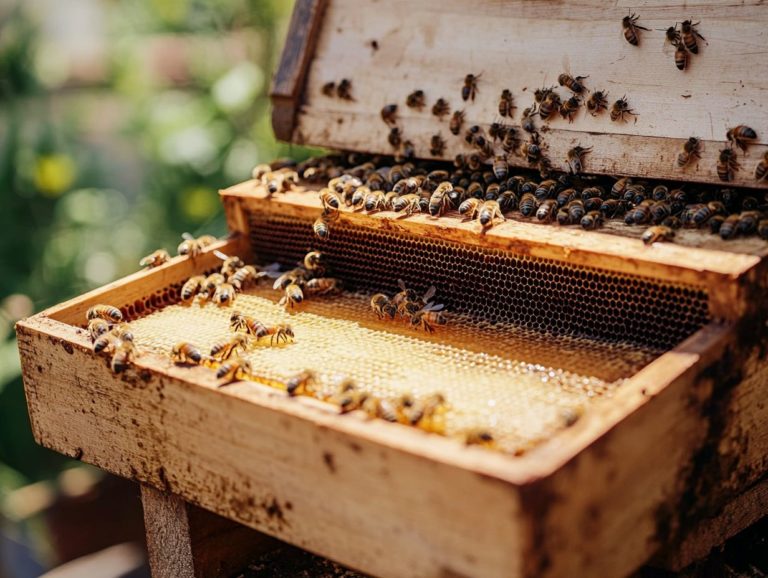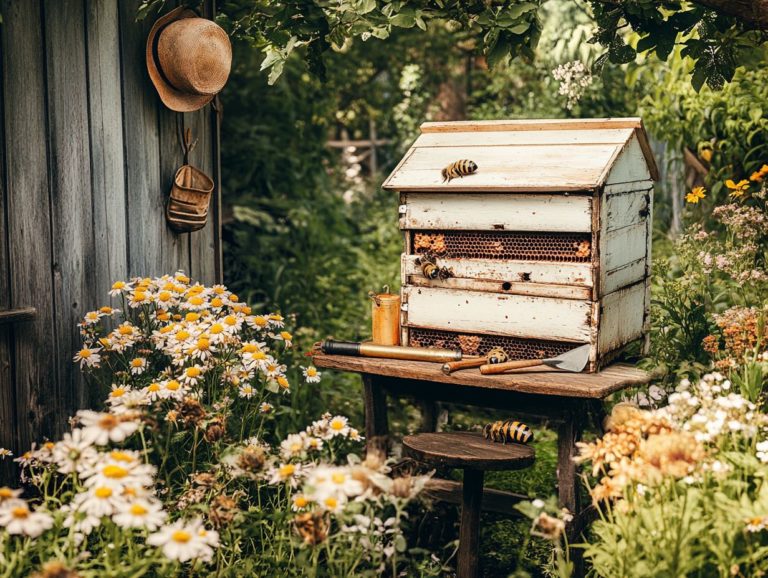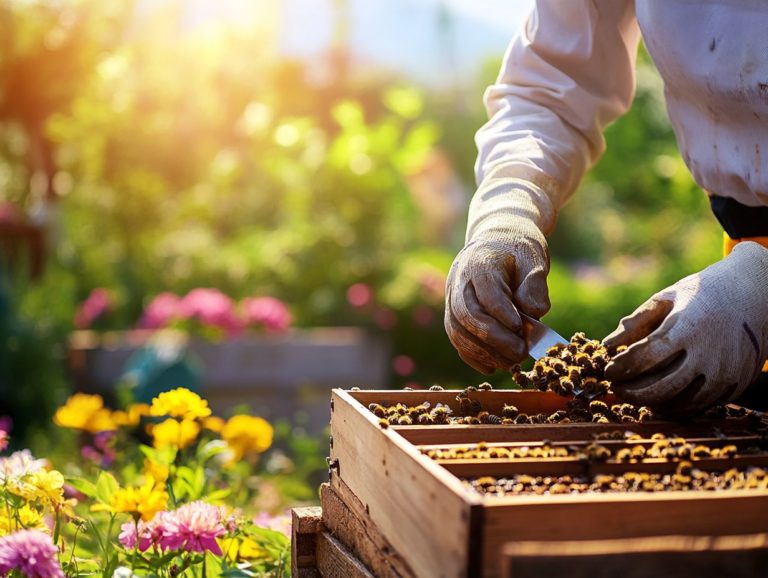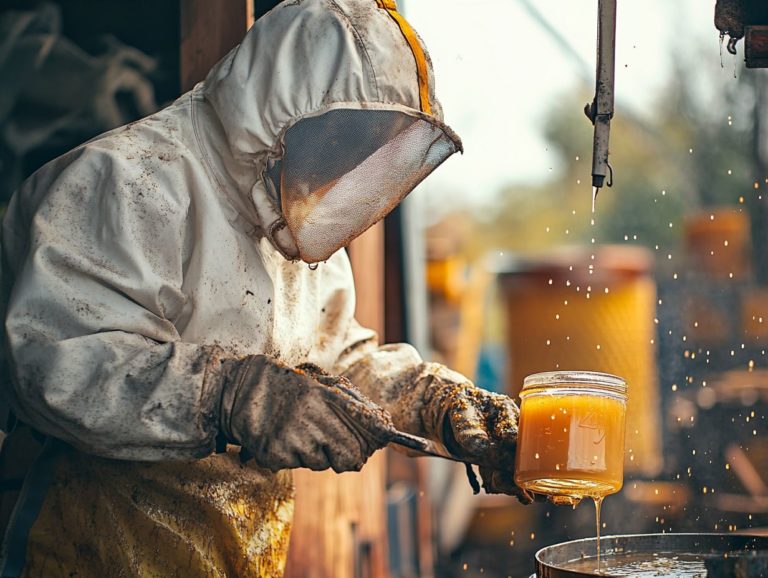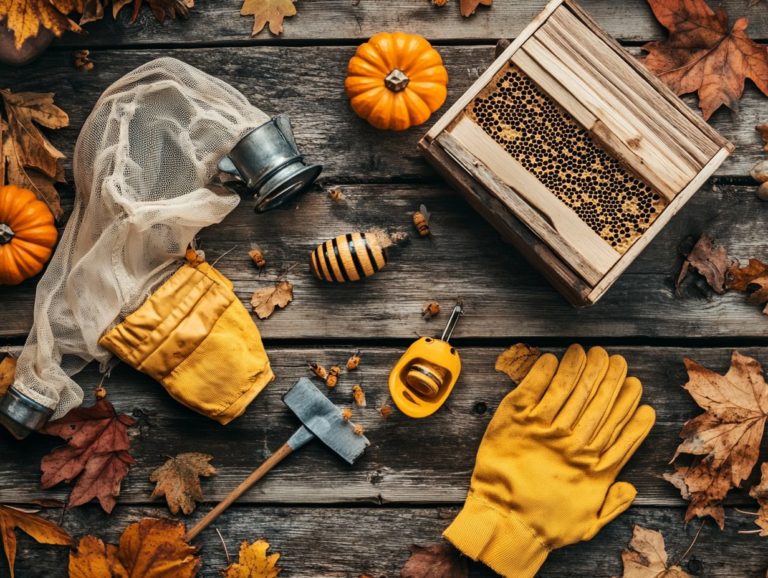How to Use a Beehive Tool Properly
Beehive tools are indispensable instruments for you as a beekeeper, playing a vital role in managing and maintaining your hives. Grasping the various types of hive tools and their specific uses can greatly enrich your beekeeping experience.
From the hive tool that expertly opens your colony to the smoker that gently soothes the bees, each tool serves its unique purpose. This guide will walk you through the different types of hive tools, highlighting their significance and demonstrating how to use them effectively, ensuring that your beekeeping journey is both safe and successful.
Contents
- Key Takeaways:
- What is a Beehive Tool?
- Why is it Important to Use a Beehive Tool?
- What are the Different Types of Beehive Tools?
- How to Use a Hive Tool?
- How to Use a Smoker?
- How to Use a Bee Brush?
- How to Use a Queen Catcher?
- How to Use an Uncapping Knife?
- What are Some Tips for Using Beehive Tools Safely?
- Frequently Asked Questions
- What is a beehive tool and why is it important to use it properly?
- How do I hold a beehive tool correctly?
- What is the purpose of the sharp edge on a beehive tool?
- Can a beekeeping tool be used for other tasks besides beekeeping?
- How do I maintain and clean a beekeeping tool?
- What are some safety precautions to keep in mind when using a beekeeping tool?
Key Takeaways:
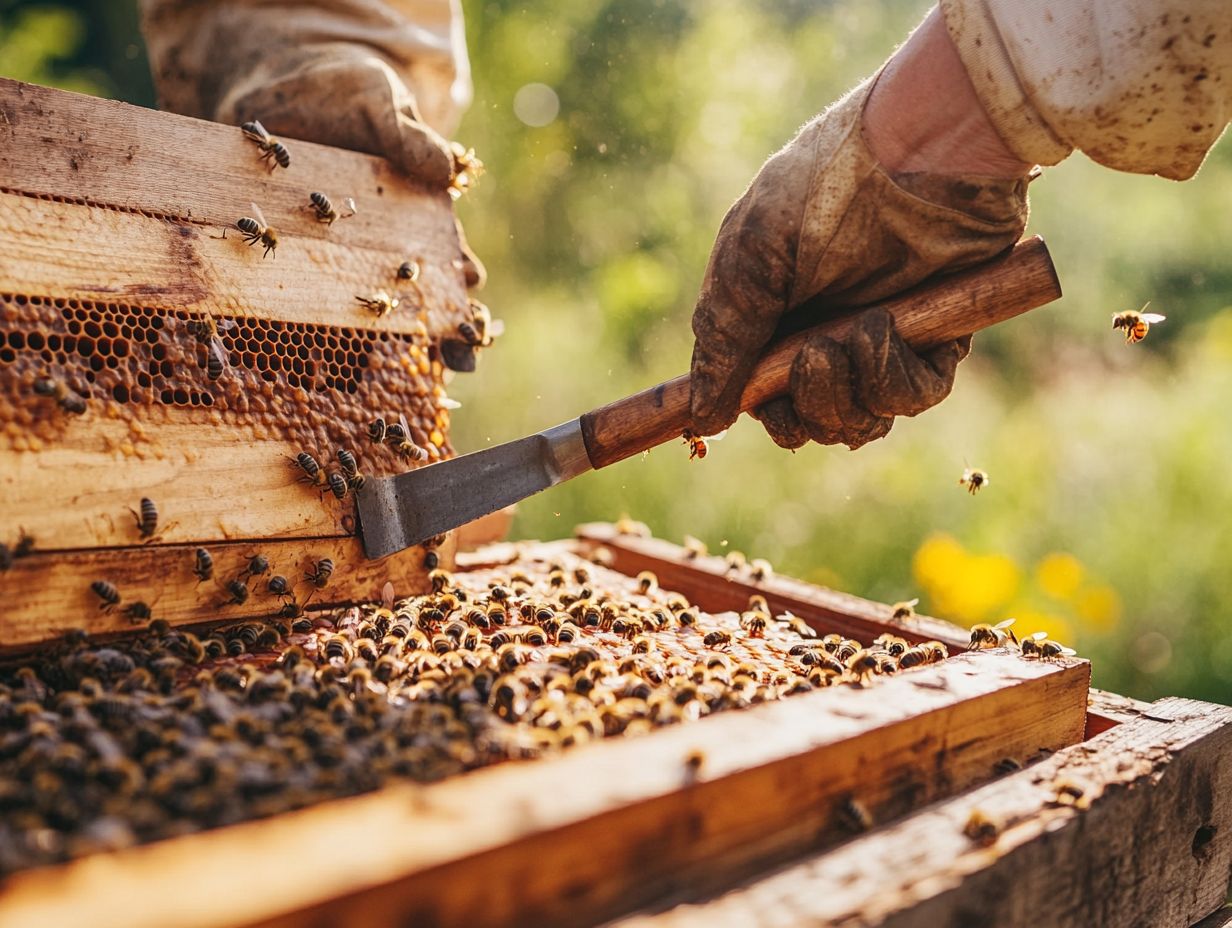
- Using the proper beehive tools is essential for efficient beekeeping and maintaining hive health.
- The three main types of beehive tools are the standard hive tool, smoker, and bee brush, each with its specific purpose.
- To use a beehive tool properly, you must understand its purpose and follow proper techniques, such as separating frames and using smoke to calm the bees.
What is a Beehive Tool?
A beehive tool is an essential instrument for any beekeeper, designed to make tasks easier in the art of beekeeping. Whether you’re inspecting hives, maintaining their components, cleaning hive surfaces, or managing the behavior of bees, these specialized tools are a must-have.
With various types and designs available, such as the J-hook hive tool and multifunction scraper, each tool serves a distinct purpose in hive maintenance, honey harvesting, and pest control. Armed with the right beehive tool, you can efficiently manage your bee yard, safeguarding the health and productivity of your colonies while ensuring minimal disruption to your bees.
Why is it Important to Use a Beehive Tool?
Using a beehive tool is crucial for your hive inspections and maintenance, as it enables you to perform essential tasks with both precision and care. Choosing the right tools helps you manage your colonies safely, monitor the queen bee’s health, and maintain an optimal environment for honey production.
This approach boosts the efficiency of your hive maintenance and helps mitigate risks linked to bee behavior, such as managing small hive beetles and ensuring the well-being of your bees. The significance of these specialized instruments goes beyond mere convenience; they greatly diminish the chances of accidents during your hive inspections.
Using a hive tool correctly allows you to separate hive components without causing undue stress to the bees and reduces the risk of injury to yourself. By employing these tools, you streamline routines such as cleaning and fumigating hives, allowing you to swiftly tackle any issues that could jeopardize both the health and productivity of your hive.
Thoughtfully applying beehive tools showcases best practices in beekeeping, demonstrating your commitment to safety and efficiency.
What are the Different Types of Beehive Tools?
You ll find a variety of beehive tools at your disposal, each meticulously crafted to tackle specific tasks within the beekeeping process. Among the essentials is the standard hive tool, a versatile companion for numerous maintenance duties, including removing frames and cleaning hive surfaces.
Then there’s the J-hook hive tool, expertly designed to remove frames while preserving the integrity of the hive components. Don’t overlook the multifunction scraper, capable of both scraping wax and propolis, and cleaning hive surfaces with ease.
Each of these tools is essential, playing a crucial role in maintaining a functional hive that promotes the health and well-being of your bees. Proper use of these tools can prevent pest control issues and ensure a healthy beekeeping environment. Equip yourself with these tools today and transform your beekeeping experience!
1. Hive Tool
A hive tool is an essential companion in your beekeeping journey. It helps you maintain and inspect your hives with ease. This tool typically boasts a flat metal blade, perfect for prying apart hive components, scraping away burr comb which is extra wax built by bees in places that aren’t part of the hive structure and removing frames for those thorough inspections you value.
With its robust construction, the hive tool offers the leverage you need to safely open beehives without harming the bees or compromising the integrity of the hive itself. You ll find it often features a forked end, which is particularly handy for extracting stubborn frames. The curved edge excels at scraping away propolis and wax buildup.
By incorporating a hive tool into your routine inspections, you can efficiently monitor the health and productivity of your colonies. This ensures that any necessary interventions are addressed promptly. This proactive approach not only leads to better hive management but also promotes longevity and boosts honey production. Don’t wait add this vital tool to your beekeeping kit today!
2. Smoker
The smoker is an important tool in your beekeeping arsenal, helping to calm bees during hive inspections. By generating smoke, you can significantly reduce bee aggression, creating a safer environment for both yourself and the bees while you conduct hive maintenance and inspections.
This device operates by producing a steady stream of smoke from suitable fuel sources like dried leaves, pine needles, or even sugar cane. The smoke serves to distract the bees, triggering their instinct to consume honey in response to a perceived threat, making them less inclined to sting. This technique ensures a smoother inspection process.
When using a smoker, prioritizing safety is of utmost importance. Always maintain your smoker at a controlled temperature to prevent burns or accidents. Proper handling enhances the effectiveness of your hive inspections and promotes a gentler interaction with the bees. This ultimately leads to healthier colonies and a more rewarding beekeeping experience. Don’t wait add this vital tool to your beekeeping kit today!
3. Bee Brush
A bee brush is a gentle yet essential tool in your beekeeping arsenal. It is designed to whisk bees off frames during hive inspections or honey harvesting safely. With this tool, you can minimize stress on the bees while effortlessly accessing vital components of the hive.
This simple yet effective implement showcases your dedication to creating a serene environment for your colonies. The soft bristles of the bee brush allow you to delicately relocate bees without causing harm, ensuring their natural behaviors remain intact. This tool is among the essential beekeeping supplies that make hive maintenance easier.
Maintaining calm bee activity during inspections not only promotes a healthier colony but also reduces the likelihood of aggressive behavior. This creates a safer experience for both you and the bees. Mastering the art of using a bee brush can significantly enhance your hive management efficiency and foster a harmonious relationship between you and your buzzing companions. Proper use also adheres to general beekeeping guidelines, ensuring the well-being of your hive. Don’t wait add this vital tool to your beekeeping kit today!
4. Queen Catcher
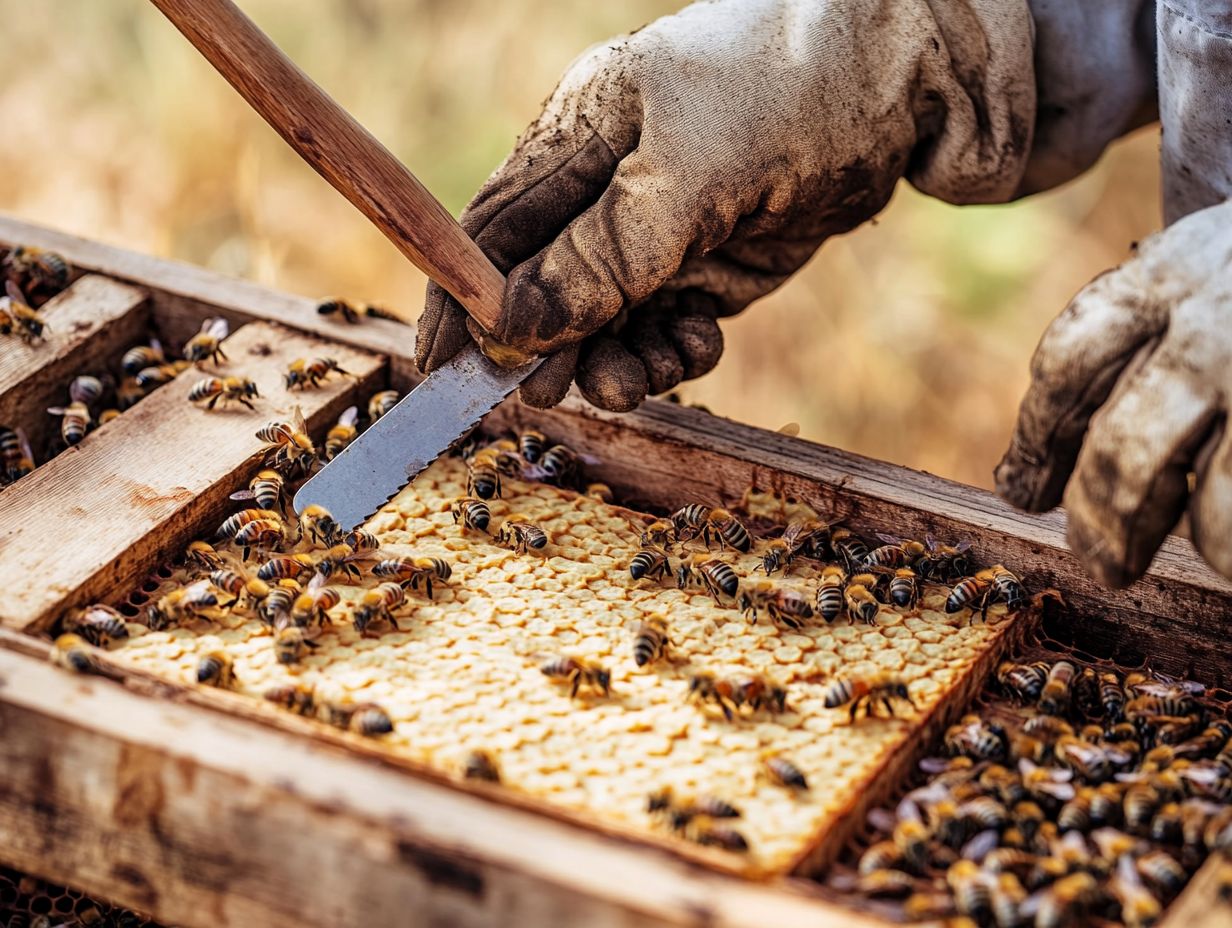
A queen catcher is an essential tool crafted specifically for the purpose of safely capturing and containing the queen bee during hive inspections or the requeening process. With this tool in hand, you can manage the queen with precision, ensuring her safety and preserving the stability of the hive. This tool is crucial for protecting equipment and ensuring optimal queen health.
A queen catcher is vital for effective beekeeping. It helps maintain order within the hive. The queen bee is the linchpin of the colony s continuity, responsible for laying eggs and sustaining the overall health of the hive. This tool also helps manage beehives effectively by ensuring the queen is safely handled during hive maintenance.
By using this tool, you can gently isolate the queen, enabling you to evaluate her health or introduce a new queen without risking harm to her or causing turmoil among the worker bees. The process typically involves gently guiding the queen into the catcher, ensuring minimal stress and disruption to the colony. Proper use of a queen catcher showcases advanced beekeeping practices and techniques.
Such meticulous management fosters a harmonious and productive hive environment, allowing your beekeeping efforts to thrive. It also helps in safely storing beehives without causing unnecessary stress to the colony.
5. Uncapping Knife
An uncapping knife is an essential tool for you as a beekeeper engaged in honey harvesting. This tool is designed to effortlessly remove the wax cappings from honeycomb cells before extraction, enabling you to retrieve honey efficiently while maintaining the integrity of the comb. This tool is among the recommended beekeeping equipment for optimal honey production.
When you use an uncapping knife correctly, you not only streamline the harvesting process but also significantly contribute to the quality of the honey produced. A skillfully executed uncapping technique reduces the risk of damaging the cells, fostering a healthier hive and more productive bees in the long run. It s crucial to handle the knife with care, fully appreciating the delicate nature of the honeycomb.
With the right technique in your toolkit, you can minimize waste and optimize extraction, ultimately delivering a honey product that reflects your dedication and the natural bounty provided by your bees. Using an uncapping knife the right way shows your commitment to responsible beekeeping.
How to Use a Hive Tool?
Effectively using a hive tool involves a series of steps that ensure your hive inspection process unfolds smoothly and safely. Proper maintenance of hive tools is also essential.
- Wear protective clothing to minimize the risk of stings as you approach the hive.
- Use the hive tool to carefully pry apart the hive components, granting you access to the frames for thorough inspection.
- Address cleaning tasks, such as scraping away excess wax, removing burr comb, and cleaning hive components, ensuring your bees have a well-maintained home.
1. Opening the Hive
Opening the hive marks the beginning of your hive inspection process, where you ll use your hive tool, a critical piece of beekeeping equipment, to gently pry apart the lid or supers without causing damage. This task requires a delicate touch, as you ll need to apply leverage carefully to avoid unnecessary harm to the bees.
Approaching the hive with a calm demeanor is essential; bees are remarkably sensitive to agitation and may respond defensively. Understanding bee behavior is equally important; by observing their flight patterns and sounds, you can gain valuable insight into the mood of the colony during your hive inspection.
As you utilize the hive tool, consider both the angle and amount of pressure you apply. This consideration will help you detach the hive parts effectively while minimizing any unease among the bees. Keeping your workspace organized and maintaining a steady rhythm during the inspection will contribute to a smoother and less stressful experience for both you and the bees. Remember, beekeeping also involves understanding and using various hive tool types, like the standard hive tool, J-hook hive tool, and multifunction scraper for different tasks. Practice these techniques to build your confidence.
2. Separating Frames
Separating frames during a hive inspection requires finesse. You use your hive tool to delicately lift and remove frames without disturbing the bees or damaging the comb. This step is crucial for your bees’ health and happiness, as it allows you to assess bee health, honey production, and the overall condition of the hive.
Using a frame lifter can also aid in this process, making it easier to handle frames. Approach the hive calmly and with purpose to keep the bees relaxed. Start by gently tapping the hive tool against the frame to loosen any honeycomb attachment before lifting. This technique prevents the frames from breaking and preserves the integrity of the entire structure.
Stay attuned to the bees behavior, as sudden movements may provoke defensive reactions. Protective clothing is a wise choice to prevent stings and ensure a safer inspection.
To further reduce stress on the hive, consider scheduling your inspections on warm, sunny days when the bees are more relaxed and less likely to cluster tightly. By creating a gentle and tranquil atmosphere, you enhance the likelihood of a successful inspection and contribute to a healthier hive environment.
These hive maintenance tips can be crucial for effective beekeeping practices. So gear up and dive into your hive!
3. Scraping Propolis and Wax
Scraping propolis and wax from the hive components is not just a chore; it s a crucial maintenance task that significantly enhances the overall health of your hive. Propolis is a resinous substance bees make to seal unwanted spaces in the hive. As a beekeeper, utilizing your hive tool will allow you to effectively remove these substances, which can accumulate over time and impede proper airflow and accessibility within the hive.
Burr comb refers to the extra comb that bees build in unwanted areas, and it can also be an issue that needs attention during these maintenance sessions. Regularly addressing this maintenance not only boosts ventilation and minimizes the risk of diseases, but it also cultivates a more inviting atmosphere for your bees, fostering optimal foraging and egg-laying behaviors.
Maintaining a clean hive is essential in preventing pests such as small hive beetles and mold from taking hold, both of which can be detrimental to your bee population. Employing techniques like using a scraper or a putty knife will enable you to efficiently collect bee propolis without causing damage to the hive structure.
By making these cleaning routines a priority, you can support your colonies and ensure a thriving and productive environment throughout the seasons. Follow these tips and watch your bees thrive!
How to Use a Smoker?
Utilizing a smoker is an essential element of beekeeping that significantly aids in calming bees during hive inspections and maintenance activities. By producing smoke, you can effectively diminish bee aggression, fostering a safer environment for both yourself and the bees. This tool should be part of your standard beekeeping supplies.
This makes hive inspections smooth and worry-free, allowing you to engage with your bees with confidence and care.
1. Preparing the Smoker
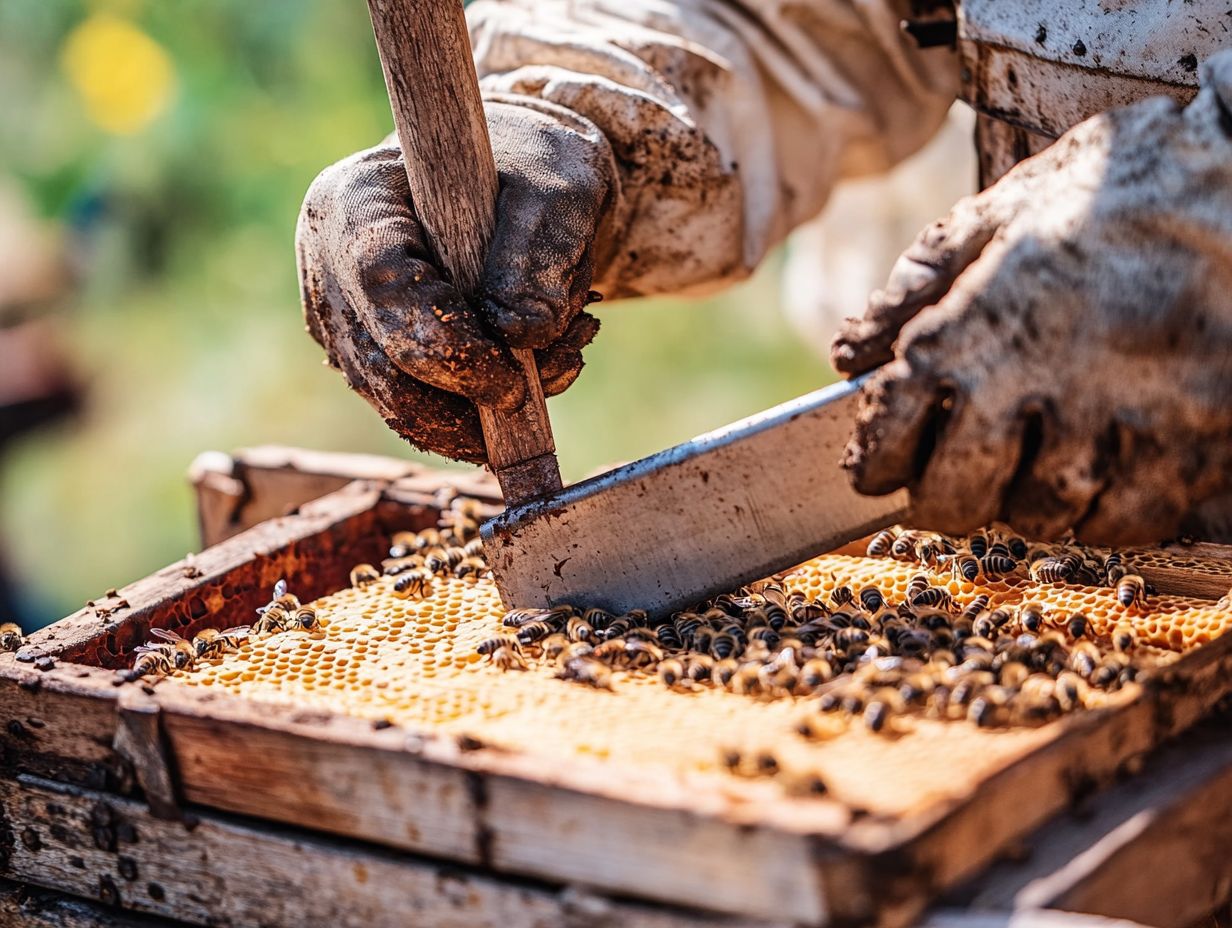
Preparing your smoker involves choosing the right fuel types, such as wood chips, pine needles, or burlap, and making sure the smoker is clean and in good working order. This initial preparation is key to producing consistent smoke that effectively calms the bees.
Regularly cleaning hive tools, including your smoker, ensures their longevity and effectiveness. Your careful selection of fuel not only impacts the quality of the smoke but also plays a significant role in the smoker s overall performance during hive inspections.
It s essential to keep the smoker free from residue; any buildup can obstruct airflow and lead to inefficient burning. Regular maintenance like cleaning and checking for blockages ensures that your smoker operates smoothly and reliably.
A well-prepared smoker is an essential tool during hive inspections, helping to reduce stress on the bees and allowing for more seamless interactions. This attention to detail can be crucial for the health of your colony.
2. Lighting the Smoker
Lighting your smoker requires a delicate touch to ensure a steady stream of smoke that won t overwhelm your bees. As a beekeeper, you’ll want to follow a few specific steps to ignite the fuel and maintain a proper burn. This is essential for effective hive inspection and managing beehives.
- Select the right type of fuel: use dry leaves, pine needles, or wood pellets for the best smoke production. These options provide consistent smoke without harmful chemicals.
- Light the smoker from the bottom. This allows air to fan the flames as they rise.
- Once you have a gentle fire going, gradually add more fuel to keep the smoker lit throughout your inspection.
You can also regulate airflow through the smoker’s bellows (the part that helps push air) to control smoke intensity. This creates a calm atmosphere that soothes the bees, allowing you to better understand hive dynamics.
3. Using the Smoker
When using the smoker, gently apply smoke around the hive entrance and over the frames during your inspection. This delicate touch helps reduce bee agitation and fosters a calm environment, ensuring the inspection process unfolds smoothly!
Timing plays an important role here. Smoke the hive just before diving into the inspection so the bees can respond to the soothing effects of the smoke. Opt for small puffs instead of overwhelming clouds, as too much smoke can disorient the bees rather than calm them.
As you observe their behavior, you ll be able to gauge the hive s reaction. If the bees seem more active or a bit aggressive, adjust your smoke application. By carefully monitoring these indicators, you can enhance the overall experience for yourself and the bees!
How to Use a Bee Brush?
Using a bee brush is an exceptionally gentle method for you as a beekeeper to remove bees from frames during inspections and honey harvesting. This tool minimizes stress on the bees and allows you to inspect hive components without jeopardizing the bee population.
To effectively use a bee brush, lightly brush the bees away from areas of interest, such as honeycomb or brood frames (where baby bees develop). A soft touch encourages their movement while keeping panic at bay.
Approach this task with calmness and deliberation. Make sure you don t accidentally squish any bees in the process. By maintaining this gentle interaction, you foster a harmonious atmosphere within the hive, contributing to stable bee behavior.
This practice also simplifies your inspection process and helps preserve the integrity of the hive ecosystem, leading to healthier bee colonies!
How to Use a Queen Catcher?
Using a queen catcher effectively is essential for a beekeeper managing the queen bee during hive inspections or requeening procedures. This specialized tool allows for the safe capture and handling of the queen without harming her or the surrounding bees.
To start, ensure the hive environment is calm, ideally during a cooler part of the day when the bees are less active. Approach the queen gently, as she is usually found on the frame with brood. Use the queen catcher to carefully enclose her, keeping the tool steady to avoid startling her.
Once you’ve captured the queen, prioritize her safety by placing her in a secure, shaded location, especially during transport. Proper handling minimizes stress on the queen, facilitating a smoother transition or eventual release back into the hive, which is crucial for maintaining a healthy bee colony.
How to Use an Uncapping Knife?
Using an uncapping knife is an essential step in your honey harvesting journey. It allows you to elegantly remove the wax cappings from honeycomb cells for extraction. This tool streamlines the honey harvesting process and helps preserve the delicate structure of the honeycomb. Keeping your beekeeping equipment in good condition, including your uncapping knife, is crucial for efficient honey extraction.
Mastering the art of using an uncapping knife requires a blend of steady hands and a discerning eye for detail. Strive for precision by gently gliding the knife along the capping to avoid damaging the comb beneath.
Maintaining a consistent angle and pressure is vital; this approach not only speeds up the uncapping process but also minimizes waste. Warming the knife to the right temperature can significantly enhance your efficiency, leading to cleaner cuts and a more refined harvest.
Your careful attention makes all the difference in your honey harvest! Any missteps can compromise the quality of your honey and the health of your hive, so take your time and enjoy the process.
What are Some Tips for Using Beehive Tools Safely?
When using beehive tools, it s important to follow beekeeping techniques that prioritize safety and hive integrity. Always wear protective clothing to minimize the risk of stings. Handle tools like the hive scraper and standard hive tool with care to avoid damaging the hive components. Regularly cleaning hive tools ensures they remain effective and safe for use.
Using beehive tools safely is essential for your well-being and that of the bees. This ensures that your hive inspections and maintenance tasks are carried out without unnecessary risks. By adhering to safety precautions and proper beekeeping guidelines, you can prevent accidents and contribute to the overall health of your bees.
Key beekeeping guidelines include using a hive scraper and ensuring regular hive maintenance. To achieve this, invest in high-quality protective clothing, such as well-fitting bee suits with veils to minimize your exposure to stings.
Before approaching the hive, remember that gentle movements can significantly reduce stress for the bees. Sudden actions might provoke them. Using beekeeping equipment properly, such as a hive tool and J-hook hive tool during inspections, is necessary.
Utilizing the right handling techniques, like employing a smoker to calm the colony during inspections, will facilitate a more seamless interaction. Inspecting hive components carefully and using a frame lifter can also contribute to effective hive management.
Maintaining a clean and organized hive area helps prevent potential mishaps, resulting in a better experience for both you and the bees. Regular cleaning of hive components and removing burr comb and bee propolis are part of essential hive maintenance. By taking these thoughtful steps, you can nurture a harmonious environment that fosters a productive relationship benefiting everyone involved.
Frequently Asked Questions
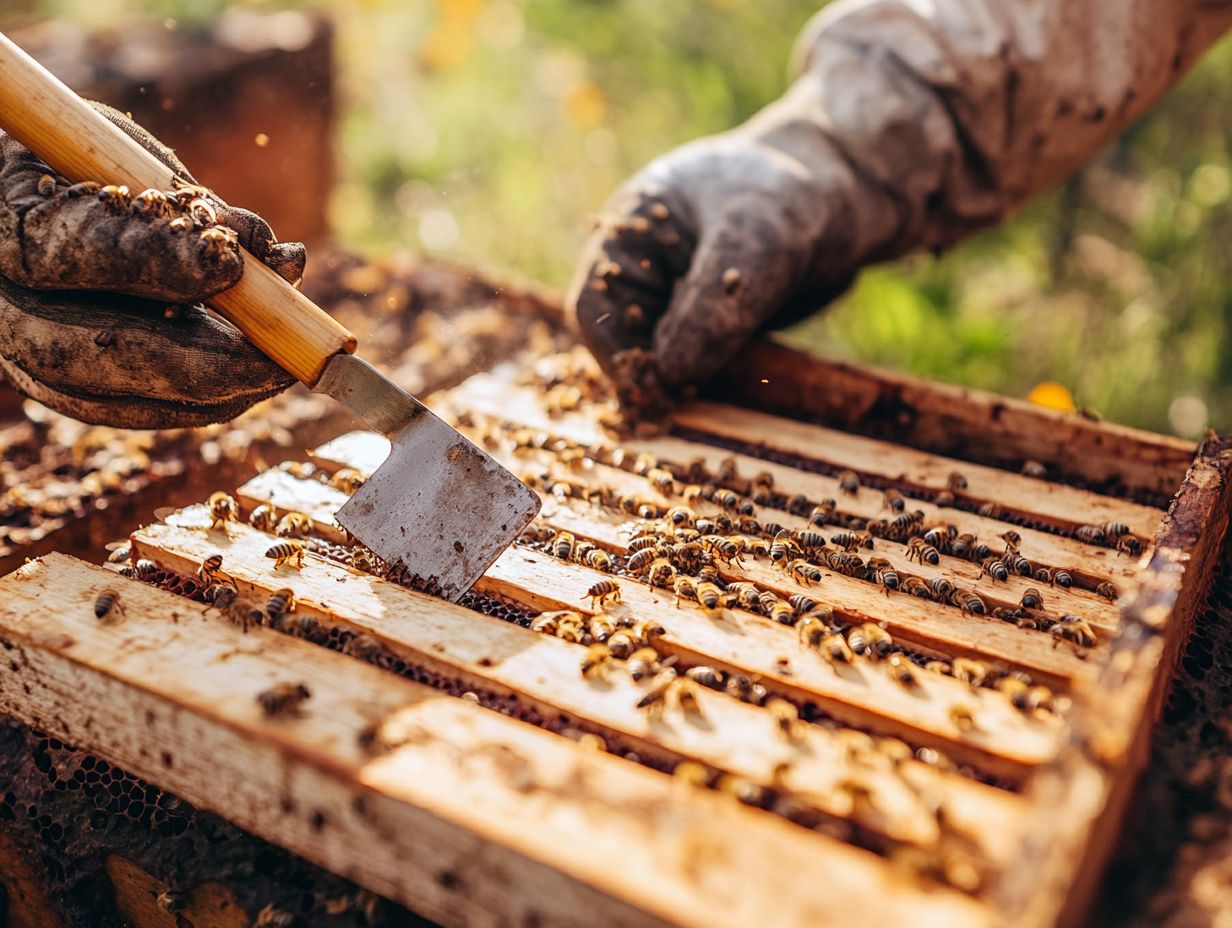
What is a beehive tool and why is it important to use it properly?
A beehive tool is a key piece of beekeeping equipment. There are different types of hive tools, including the standard hive tool and multifunction scraper. Proper use ensures the safety and health of both the bees and the beekeeper.
How do I hold a beehive tool correctly?
A beehive tool should be held with a firm grip on the handle, with the blade pointing away from you. This will prevent injury and allow for better control of the tool. The hive inspection process often involves removing frames and scraping wax, so maintaining a firm grip is crucial.
What is the purpose of the sharp edge on a beehive tool?
The sharp edge on a beehive tool is used to scrape and pry open hive components such as frames, supers, and hive bodies. It is important to use this edge carefully to avoid damaging the hive or injuring the bees. Beekeeping techniques like this help manage beehives effectively.
Ready to start harvesting honey? Grab your uncapping knife and let’s get to work!
Can a beekeeping tool be used for other tasks besides beekeeping?
A beekeeping tool is mainly for beekeeping, but it can help in gardening, landscaping, and other outdoor activities that involve prying or scraping. Just remember to clean it thoroughly before using it in these other areas to stop any disease spread among bee colonies.
How do I maintain and clean a beekeeping tool?
After each use, clean the tool with soap and water to remove any residue. Then, use a bleach and water solution to thoroughly sanitize it and stop diseases from spreading among bee colonies.
Inspect the tool for any damage. If it s damaged, replace it to ensure safe and effective use.
What are some safety precautions to keep in mind when using a beekeeping tool?
Safety first! Protect yourself with gloves, a veil, and a bee suit when using your beekeeping tool. Work calmly and slowly to avoid agitating the bees, and make sure you secure the hive components properly after use to prevent accidents.

